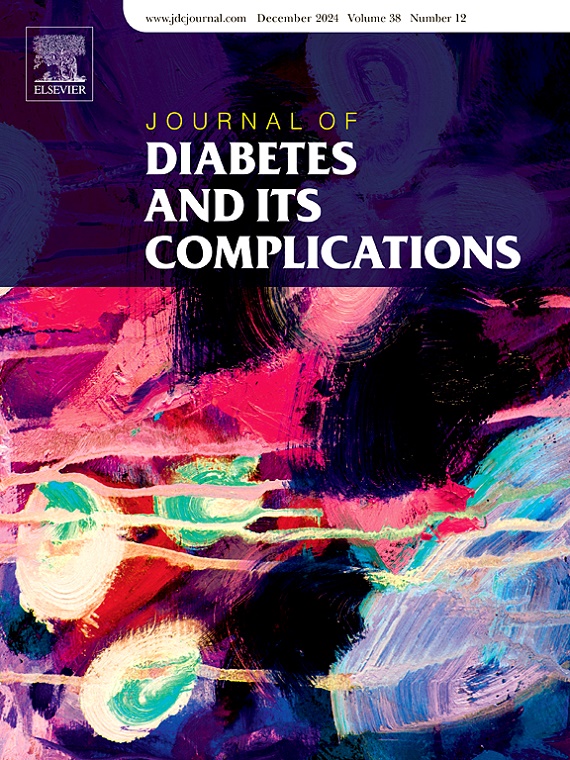Liraglutide improves senescence and ameliorating diabetic sarcopenia via the YAP-TAZ pathway
IF 3.1
3区 医学
Q3 ENDOCRINOLOGY & METABOLISM
引用次数: 0
Abstract
Objective
Beyond its established glucose-lowering and weight-reducing benefits, glucagon-like peptide-1 receptor agonists (GLP-1RAs) such as liraglutide may also mitigate sarcopenia. This study investigates the effects of liraglutide on diabetic sarcopenia and its underlying mechanisms.
Methods
A type 2 diabetic SD rat model was induced using a high-fat, high-sugar diet supplemented with a low dose of streptozotocin. Comparisons were made among control (Con), diabetic (DM), and liraglutide-treated (Li) groups for gastrocnemius muscle wet weight and length, histology (HE staining), immunofluorescence for muscle fiber typing, and Western blotting for aging-related proteins and YAP/TAZ pathway components. Concurrently, C2C12 myoblasts were differentiated into myotubes, treated with 60 mM glucose to model diabetic conditions, and assessed for morphological changes, senescence (SA-β-gal staining), and protein expression dynamics.
Results
Diabetic rats displayed significant reductions in muscle mass, length, and cross-sectional area, along with disorganized fiber architecture, all of which were improved by liraglutide. In vitro, C2C12 myotubes showed accelerated aging and atrophy under high-glucose conditions, which were significantly reduced by liraglutide. Analysis revealed increased expression of aging markers P53 and P21 and decreased YAP/TAZ/TEAD and Cyclin D1 levels in diabetic conditions, which were reversed following liraglutide treatment. The inhibition of YAP significantly negated the protective effects of liraglutide.
Conclusion
High glucose promotes muscle cell aging and sarcopenia, processes that liraglutide can attenuate by modulating the YAP/TAZ signaling pathway. This study underscores liraglutide's potential to alleviate muscle degeneration in diabetic sarcopenia through its regulatory impact on critical aging pathways.
利拉鲁肽通过YAP-TAZ途径改善衰老和糖尿病性肌肉减少症
利拉鲁肽等胰高血糖素样肽-1受体激动剂(GLP-1RAs)除了具有既定的降糖和减肥功效外,还可以缓解肌肉减少症。本研究探讨利拉鲁肽对糖尿病性肌肉减少症的影响及其潜在机制。方法采用高脂、高糖饮食加低剂量链脲佐菌素诱导2型糖尿病SD大鼠模型。比较对照组(Con)、糖尿病组(DM)和利拉鲁肽组(Li)腓肠肌湿重和长度、组织学(HE染色)、肌纤维分型的免疫荧光、衰老相关蛋白和YAP/TAZ通路成分的Western印迹。同时,将C2C12成肌细胞分化为肌管,用60 mM葡萄糖处理以模拟糖尿病,并评估形态学变化、衰老(SA-β-gal染色)和蛋白表达动态。结果糖尿病大鼠肌肉质量、长度和横截面积明显减少,纤维结构紊乱,利拉鲁肽均能改善这些症状。体外高糖条件下,C2C12肌管衰老和萎缩加速,利拉鲁肽显著降低了这一现象。分析显示,糖尿病患者衰老标志物P53和P21的表达增加,YAP/TAZ/TEAD和Cyclin D1水平降低,利拉鲁肽治疗后这一情况逆转。YAP的抑制作用显著地抵消了利拉鲁肽的保护作用。结论高糖促进肌肉细胞衰老和肌肉减少,利拉鲁肽可通过调节YAP/TAZ信号通路减弱这一过程。这项研究强调了利拉鲁肽通过其对关键衰老途径的调节作用来缓解糖尿病性肌肉减少症的肌肉变性的潜力。
本文章由计算机程序翻译,如有差异,请以英文原文为准。
求助全文
约1分钟内获得全文
求助全文
来源期刊

Journal of diabetes and its complications
医学-内分泌学与代谢
CiteScore
5.90
自引率
3.30%
发文量
153
审稿时长
16 days
期刊介绍:
Journal of Diabetes and Its Complications (JDC) is a journal for health care practitioners and researchers, that publishes original research about the pathogenesis, diagnosis and management of diabetes mellitus and its complications. JDC also publishes articles on physiological and molecular aspects of glucose homeostasis.
The primary purpose of JDC is to act as a source of information usable by diabetes practitioners and researchers to increase their knowledge about mechanisms of diabetes and complications development, and promote better management of people with diabetes who are at risk for those complications.
Manuscripts submitted to JDC can report any aspect of basic, translational or clinical research as well as epidemiology. Topics can range broadly from early prediabetes to late-stage complicated diabetes. Topics relevant to basic/translational reports include pancreatic islet dysfunction and insulin resistance, altered adipose tissue function in diabetes, altered neuronal control of glucose homeostasis and mechanisms of drug action. Topics relevant to diabetic complications include diabetic retinopathy, neuropathy and nephropathy; peripheral vascular disease and coronary heart disease; gastrointestinal disorders, renal failure and impotence; and hypertension and hyperlipidemia.
 求助内容:
求助内容: 应助结果提醒方式:
应助结果提醒方式:


